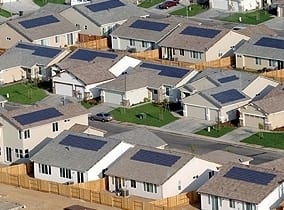AGL Energy says it is likely that nearly one-third of households in Australia will have rooftop solar by 2025, and will likely want battery storage too, creating new opportunities for households to provide much of their own energy, provide back up power and provide grid services.
At the company’s investor day presentation to analysts in Sydney on Monday, the new head of the company’s new energy division, Elisabeth Brinton, said these resources could be pooled to create “virtual power plants” that would cut network costs and also deliver savings in the wholesale markets.

Brinton cited Bloomberg New Energy Finance predictions that suggest 30 per cent of Australian households would have solar by 2025. This compares to around 16 per cent of households now.
“All of these homes are perfectly right for batteries,” Brinton said. “And once you have got solar and batteries, you have got an opportunity for a virtual power plant.”
Brinton said that AGL is assuming that the investment needed for battery storage would mean many customers would seek long-term, reliable – although her estimates of battery storage costs and opportunities did raise a few eyebrows.
Brinton suggested that for an average household solar system of 7kW (actually, in Australia the average rooftop system size is around 5kW), households would require two of the new Powerwall 2 battery units to provide back-up power for a typical 3-bedroom home.
Given that the systems, she said, cost $8,000 per unit plus $1,300 installation, that would amount to just under $20,000. “That’s a significant investment,” she noted.

It’s not entirely clear that any household needs that much power for back-up, unless they are expecting major outages. Consumers will mostly be juggling the ideas of back-up power, time shifting solar (storing excess capacity for use in the evening), and providing grid services.
Still, Brinton said there was genuine excitement among consumers, network operators, and grid operators about the potential of battery storage at a consumer level to play a significant role in the grid, and to get revenue and other benefits from that.
“(Households) really want back up power and they think it is cool … to help the good of the whole … to participate in the reliability of grid and get revenue from that.”
Brinton said that once the VPP concept was tested and rolled out in other areas, and there were “multiples of megawatts”, it would start to have an impact in the broader market.
Not only would it lower wholesale prices, it would add flexibility for the market operator and stability to the grid; and lower grid investments in poles and wires and transformers.
The trial being launched in Adelaide envisages 5MW/7MWh of battery storage spread among 1,000 households, that CEO Andy Vesey has compared to a dispatchable solar plant, effectively displacing the role of a gas peaking generator, with added network benefits.
“There is definitely room for more,” Brinton said. “We are not having to push hard to sell this idea. They have a personal value proposition from providing back-up power and lowering their bills in general.”
Interestingly, the company has abandoned its individual targets of a “million” solar homes by 2020, as Vesey switches focus from meeting hard targets to testing whether new technologies can be absorbed within the overall business strategy of the company.
For that reason, new energy will not be encouraged to rival the traditional business as once was imagined, but will serve to develop new technologies and services before handing them over to the relevant division. Solar and smart meters have already made that transition.
In the meantime, AGL announced a $65 million investment into Energy Impact Partners, a New York-based private equity/venture capital firm that specialises in new energy systems and technology. This follows its investments in Sunverge and Solar Analytics in the past year.
It also announced plans to invest $50 to $100 million in systems and customer acquisition costs to enter the WA gas retail market, targeting around 100,000 customers and, more controversially, a potential $300 million project for infrastructure to import liquified natural gas.
(RenewEconomy will have a full analysis of the investor day presentation on Wednesday).










